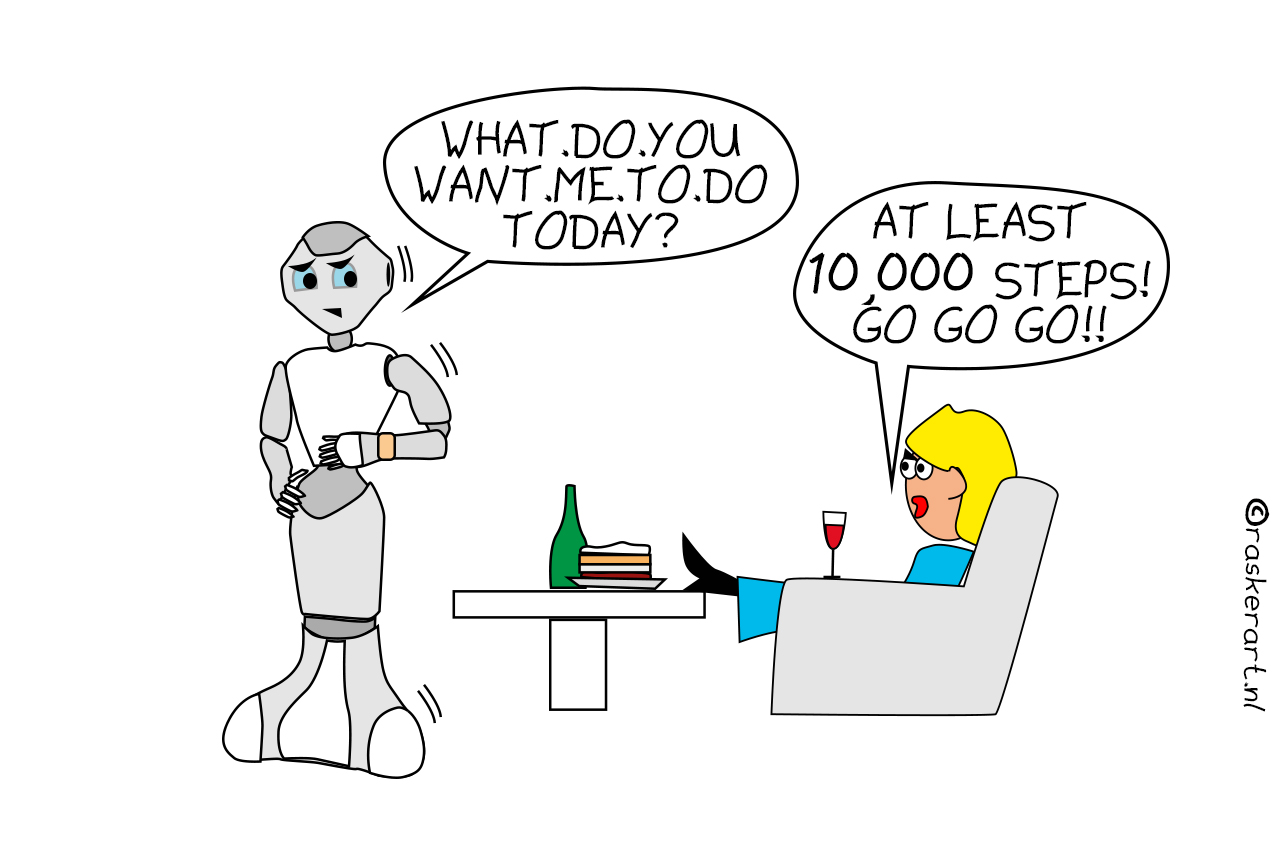
Count your steps, track your sleep, measure your heart rate and cardiac rhythms. It’s almost normal these days for a smart watch to do all of that. They can even detect a heart arrhythmia.
Sales of smart watches increased 47 % in the second quarter of 2021 compared to the second of 2020, according to figures from Strategic Analysis. Such devices provide information about how much you move and if you are living healthily. What are the pros and cons if you want to use this kind of technology to motivate people to exercise more?
Dumb motion meters
It really is necessary to get people moving, Dennis Arts believes. He is a PhD student ‘designing for an active lifestyle‘ at the Eindhoven University of Technology (TU/e). He is also a researcher with the lectorate Move to Be at the School of Sport Studies at the Fontys University of Applied Sciences in The Netherlands. “Because we all don’t move enough and sit around too much.” Only slightly more than half of the Dutch population meets the exercise guidelines, “with all the negative implications that entails.”
Arts’ interest in wearable sensors first arose in 2011. In his own words, he found the motion trackers of the time, “as dumb as they come. For example, they started beeping and vibrating to signal that you needed to stand up. Great, but sometimes just at a point when I was in the car. Such variables as context or an emotion, well, a device doesn’t take into account.” Arts applied for a PhD grant from the Netherlands Organisation for Scientific Research (NWO) to do research on wearables that can contribute to greater vitality. He was granted this in 2019.
Since then, the technology behind smart watches has improved etremendously. Doctor: “There is, in fact, nothing that a device like this cannot measure or calculate. Except measuring the glucose in your blood maybe, but apart from that almost anything is possible. Sleep, heart rate, your oxygen intake, the number of steps taken each day, stress levels. You can calculate your energy consumption and your maximum oxygen uptake. Even your heart rate variability can be calculated, which in turn can flag stress and arrhythmias.”
Objective
Especially the objective measurement of physical inactivity is a huge advantage for Arts. “People are completely unaware of how much or how long they sit in a day. Or how much they have actually moved. If you examine that using a questionnaire, then they are pretty much wrong by about half.” Research by I&O Research shows that a quarter of respondents think they get enough exercise, but they don’t in practice.
“What’s more, many people find it difficult to assess whether they are physically active at the right level of intensity. I can lounge around and do a bit of walking here and there, but is that enough? Or do I need to get my heart rate up?”
The guideline states that you ought o exercise moderately intensively for at least 150 minutes each week spread over several days. “But what is moderate intensity? What heart rate are you aiming for? Then it’s good if you can measure that objectively and give it back to the user in the form of feedback.”
Emotion
All those sensors and chips measure valuable information, Arts says. “For example, you can share that with a professional who is coaching you to do more exercise.” This then mainly involves self-monitoring and setting goals. “That’s a good thing, provided that person is very intent on wanting to move more,” he adds.
As such, it is primarily focused on the outcome, Arts says. As a lecturer at the School of Sport Studies, he challenges fourth-year students to think about how they can adapt technical applications with other behavior changing techniques. “Other than monitoring, setting goals and giving feedback. For example, techniques that focus on the user’s identity or emotion.” Recently, Daphne Menheere earned her doctorate at TU/e with innovations that link going to do sports and exercise to the feeling you get afterwards. “You then always feel good, you never come back with any regrets.”
Coaxing
More movement does not necessarily mean more sports. Within the Workplace Vitality Hub at the High Tech Campus in Eindhoven, companies are testing innovations to coax people to exercise more in the workplace. Such as the Workwalks by Ida Damen, where employees hold meetings on foot and can make use of so-called hubs that have a number of screens alongtheu way where they can take notes or download a presentation. This month Damen, who is also doing research as part of the Move to Be lectorate, received her doctorate at TU/e with her Workwalks.
It’s not just a case of putting a sensor in a desk that raises the desk after 50 minutes of working in a seated position, Arts said. “If you don’t adjust the office environment, then people don’t know why these things are done. I experienced the introduction of those kinds of desks at the School of Sport Studies. Then a colleague across from me would suddenly stand up, while I was free to remain seated. I’d then be looking straight at his crotch. That is very awkward. More exercise is a complex issue. You have to look at it from several perspectives and find a solution. Not only in terms of technology, but also together with behavioral and movement scientists, designers and the end user.”
Priority list
“Pedometers do work,” says Sander Hermsen, Principal Behavioural Scientist at OnePlanet Research Center, a joint research institute of the universities of Nijmegen and Wageningen and imec. “But these watches tend to work especially well with people who are already motivated to exercise. In addition, someone must also have the capacity, skills, peace of mind and not be under a lot of stress in order to change their behavior.”
That, according to Hermsen, is the biggest hurdle. “This is true for almost all digital interventions aimed at getting more exercise. They mainly help the people who don’t actually need it. For them, it is a kind of technical peg on which they can hang their already high levels of motivation. The data then acts as an incentive for them to go the extra mile.”
“You don’t reach people this way who should be exercising more because of their lifestyle.” A recent study by Max Western and others shows that a person’s socio-economic position, such as education or job, plays a role in the use of technical applications. Hermsen: “Everyone knows that it is healthier to exercise more, but for large groups of people, other matters are higher on their priority list.”
Like Arts, Hermsen is in favor of an integrative approach. “You have to help people figure out how they can fit more exercise into their daily lives. How can they find an opportune moment to start exercising more? What are the obstacles? What sort of practical and social support does someone need?”
Eating quickly
Apart from that, Hermsen also mentions the timing of feedback as one drawback of, for example, a pedometer. That feedback is retrospective. “If I see at ten to midnight that I still have to take two thousand steps, then I’m too late. It would be much better to get the feedback while exercising.
As an example, Hermsen worked on a study that made use of a fork as a tool to help people eat less quickly. “Eating too fast has been proven to be one of the causes of obesity and is also linked to diabetes, among other things. Eating more slowly is easier said than done. I know from experience, I am also a very fast eater.” The fork from the French company Slow Control starts to vibrate when someone takes a second bite within ten seconds. “This made people eat slower and lose weight. Even after a few months, they were still eating more slowly and those kilos were still off. They got the feedback – the vibration – at the moment they were actually engaging in that behavior. That works best.”
All apps, smart watches, and smart scales yield useful information. However, a user does need to know what to do with that information. “It’s nice that I know my cholesterol levels, for example, but I can’t do much else with it myself.”
Privacy by design
The information is not only of interest to the user. Others can also make use of it. Theoretically, manufacturers of sleeping pills, for one thing, could make use of information about a lack of sleep. That use is disputable, say both Arts and Hermsen. Hermsen also emphasizes this: “Manufacturers of digital products hardly take into account the security of sharing personal data, privacy by design, when developing a product. This can be done, say, by storing data only locally on the smartphone, or the wearable, and not passing it on to a server.”
“Companies can now amass all kinds of data for their own use. Although more and more awareness about this is gaining ground. Consumers are also becoming more conscious about this aspect. Ultimately, privacy by design can be precisely why a consumer chooses a product: they can then be sure that their data will not end up anywhere else.”
Technology is not the solution, according to Hermsen, but “we do need to make smart use of it.” He compares it to an orchestra. “For some pieces of music, all you need is a violin. For others, the entire symphony orchestra has to turn up. For some problems, a minor technological intervention is the solution and for others, you will have to look much more widely.”





